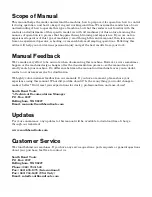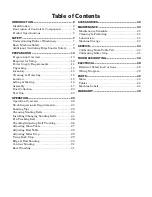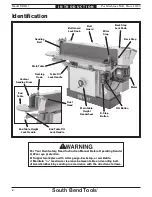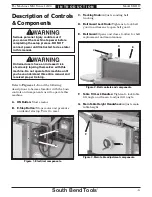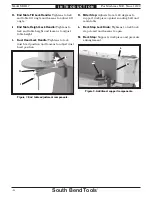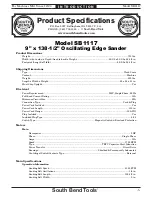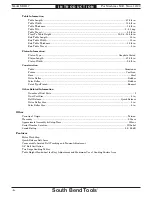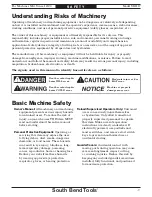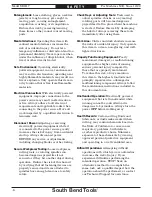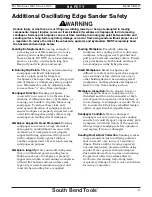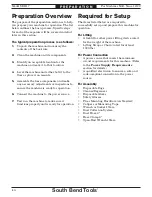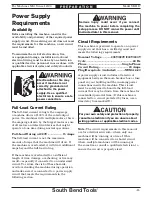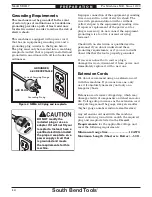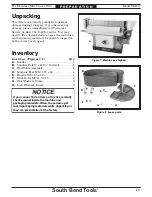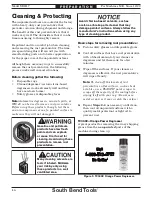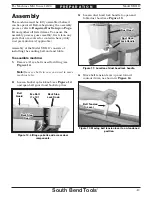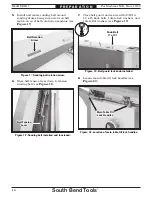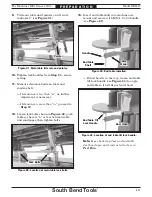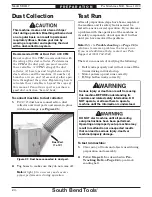
South Bend Tools
For Machines Mfd. Since 12/20
Model SB1117
-9-
S A F E T Y
Additional Oscillating Edge Sander Safety
Feeding Workpiece.
Forcefully jamming
workpiece into sanding surface could cause
workpiece to be aggressively grabbed and
pull your hands into sanding surface. Firmly
grasp workpiece in both hands and ease it
into sandpaper using light pressure.
Small Workpieces.
Small workpieces are
difficult to control and require close support
near sanding surface. Always use a jig or
other holding device when sanding small
workpieces, and keep hands and fingers at
least 2" away from sanding surface.
Workpiece Inspection.
Nails, staples, knots, or
other imperfections in workpiece can be
dislodged and thrown from sander at high
rate of speed into operator or bystanders, or
cause damage to sandpaper or sander. Never
try to sand stock that has embedded foreign
objects or questionable imperfections.
Sandpaper Condition.
Worn or damaged
sandpaper not only produces poor sanding
results, but could fly apart, aggressively grab
workpiece, and throw debris at the operator.
Always inspect sandpaper before operation
and replace if worn or damaged.
Sanding Dust & Dust Collection.
Sanding creates
large amounts of dust and flying particles
that can lead to eye injury or respiratory
illness. Reduce risk by wearing approved
eye and respiratory protection when using
sander. Never operate without adequate
dust-collection system in place and running.
Proper dust collection reduces dust in
work area, decreasing risk of long-term
respiratory damage, but it is not a substitute
for using a respirator.
Avoiding Entanglement.
Becoming entangled
in moving parts of this machine can cause
pinching and crushing injuries. To avoid
these hazards, DO NOT wear loose clothing,
gloves, or jewelry, and tie back long hair.
Keep all guards in place and secure.
In-Running Nip Points.
The gap between moving
sandpaper and fixed table/support
creates a pinch point for fingers or
workpieces; the larger this gap is, the greater
risk of fingers or workpieces getting caught
in it. Minimize this risk by adjusting table
no more than
1
⁄
16
" away from sandpaper.
Sandpaper Direction.
Feeding workpiece
incorrectly can cause it to be thrown from
machine, striking operator or bystanders, or
causing your hands to slip into the moving
sandpaper. To reduce these risks, only
sand against direction of sandpaper travel,
ensure workpiece is properly supported, and
avoid introducing sharp edges into moving
sandpaper on leading side of workpiece.
Workpiece Support & Hand Placement.
Rotating
sandpaper can remove a large amount of
skin quickly, and kickback can occur with
violent force if workpiece is not properly
supported during operation. Always sand
with workpiece firmly against table or
another support device. Never touch moving
sandpaper on purpose.
Workpiece Integrity.
Only sand solid workpieces
that can withstand power sanding forces.
Make sure shape of workpiece is properly
supported on table; avoid sanding workpieces
without flat bottom surfaces unless some
type of jig is used to maintain support and
control when sanding force is applied.
Serious injury or death can occur if fingers, clothing, jewelry, or hair get entangled in moving
components. Impact injuries can occur from kickback if workpiece is improperly fed into moving
sandpaper. Serious pinch injuries can occur from touching in-running nip point between table and
sanding surface. Long-term respiratory damage can occur from using sander without proper use of
a respirator. To reduce the risk of these hazards, operator and bystanders MUST completely heed
the hazards and warnings below.
Содержание SB1117
Страница 48: ...southbendtools com Printed In Taiwan CS21567...


